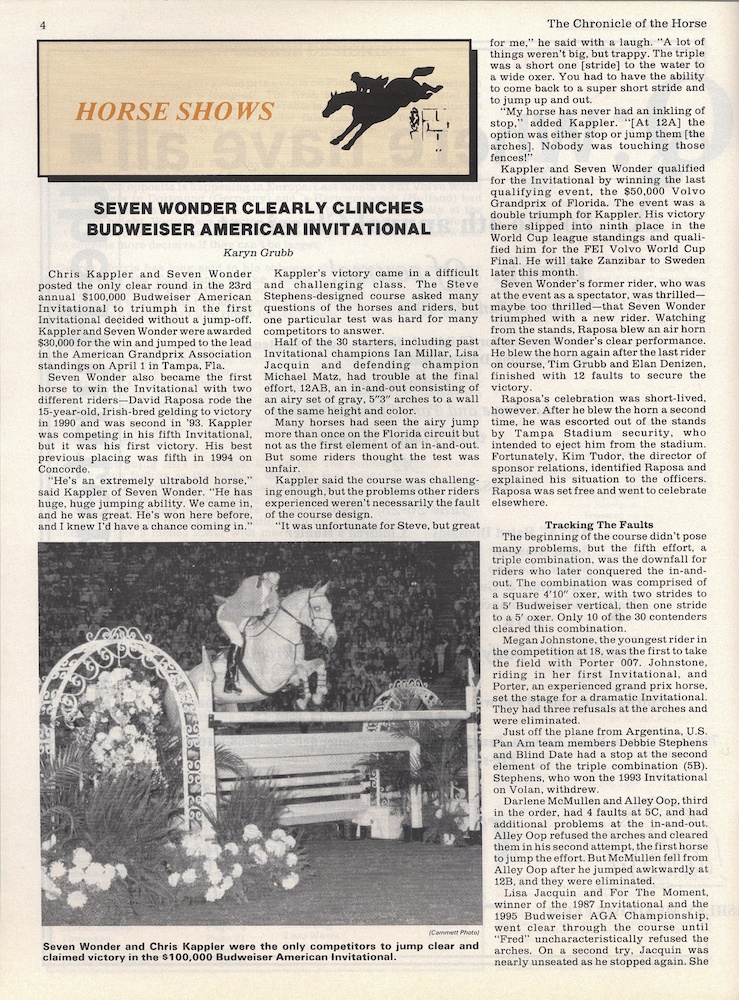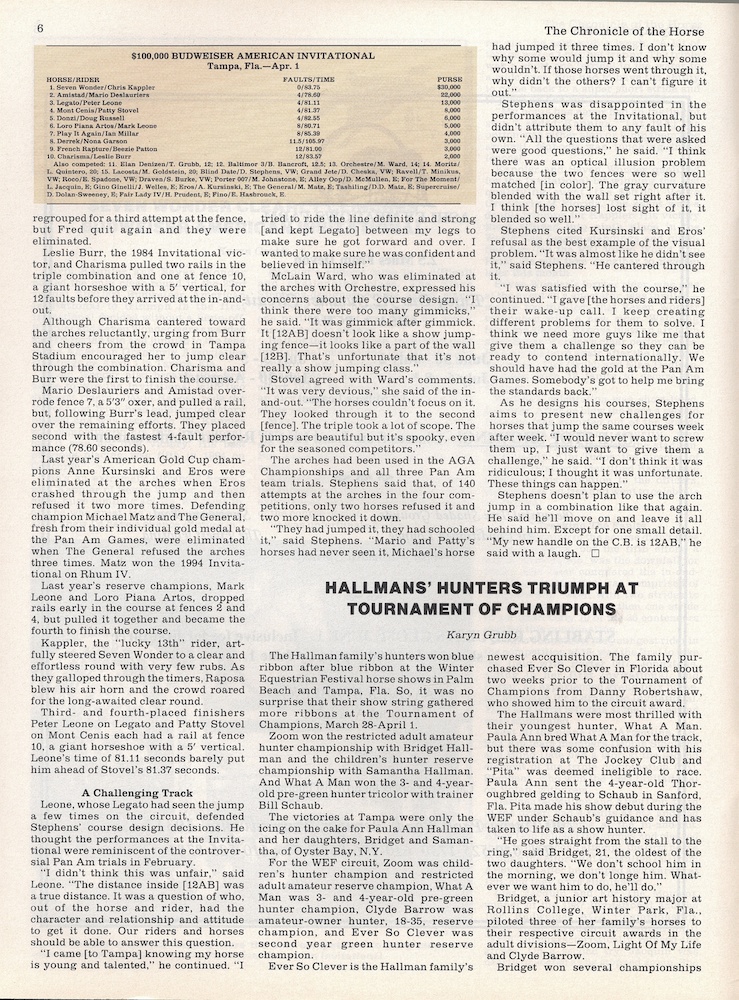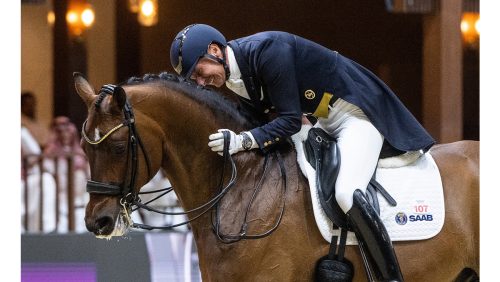It was the wall that dashed the American Invitational dreams of many big names. For the 1995 $100,000 Budweiser American Invitational, Steve Stephens used an airy wall of arches as the A element of the last combination on course. And it was a question that one rider described as “devious.”
Famous names like For The Moment and Lisa Jaquin, Eros and Anne Kursinski, Charisma and Leslie Burr (Howard) all came to grief at the wall of arches. Only 15 of the 30 starters actually finished the course that year.
And so it was that Chris Kappler, then 28, jumped the only clear round to take a remarkable victory.
“That was one of the highlights of my riding career,” Kappler said. “I loved the Invitational, and I had yet to win it. Every year I went really hungry to win that class.
“That year, I went lucky 13th in the order,” he said. “I remember everyone was having so much trouble. It was hard in those days to know what was going on in the class. There was no TV monitor, you couldn’t really watch the course, we just heard that everybody was having a difficult time getting through the last double of walls.
“Nobody was jumping clean, there were a lot of eliminations,” he continued. “I knew Seven Wonder was a really bold horse, so I wasn’t worried about him stopping. I guess my main thing was to make sure I was putting in as few faults as possible because it seemed like nobody was going clean.
“I remember I had a really good warm-up; he felt great. We got in the ring, and he was a little tense for the first few jumps; I had a couple of pretty hard rubs. But then he seemed to just relax into the course. I was heading to the last double of walls, and I met it just like I wanted to, in stride. I actually tried to under-ride the walls a little bit because I was worried—I didn’t want to let the thought of all the eliminations there influence my ride. I tried to ride him really soft through there, and he came out over the second jump clean.
ADVERTISEMENT
“The crowd erupted, and it was really one of my most memorable moments. It had been a bit of a bloodbath to that point, and I ended up being the only clear round and winning.”
The win helped Kappler get named to U.S. Nations Cup teams in Europe that summer. “I got to go to Hickstead [England], Arnhem [the Netherlands] and Aachen [Germany], which was my first time at Aachen. It was kind of the beginning of my first really big international stint of success,” he recalled.
Seven Wonder had actually won the American Invitational before—in 1990 with David Raposa riding. According to the Chronicle coverage of Kappler’s win, Raposa almost got kicked out of the Tampa stadium for blowing an air horn to celebrate Kappler’s victory.
“Seven Wonder’s former rider, who was at the event as a spectator, was thrilled—maybe too thrilled—that Seven Wonder triumphed with a new rider. Watching from the stands, Raposa blew an air horn after Seven Wonder’s clear performance. He blew the horn again after the last rider on course, Tim Grubb on Elan Denizen, finished with 12 faults to secure the victory,” Karyn Grubb wrote in the Chronicle’s coverage.
“Raposa’s celebration was short-lived, however. After he blew the horn a second time, he was escorted out of the stands by Tampa Stadium security, who intended to eject him from the stadium. Fortunately, Kim Tudor, the director of sponsor relations, identified Raposa and explained his situation to the officers. Raposa was set free and went to celebrate elsewhere.”
Kappler remembers Seven Wonder very fondly, though the horse was known for not being the easiest ride. “He was a very quirky horse. He was a lifetime cold-backed horse. From the minute you put the saddle on, you had to be so delicate about putting the girth up. It really took a while,” Kappler said.
ADVERTISEMENT
“You had to let him longe and get to the point where he was comfortable. I remember David Raposa telling me, ‘Just longe him a bit, or he will buck you off.’ And he would! Even if you had to get back on him to warm up for the jump-off and had ridden him around the first round, you had to do the routine again. Otherwise, you were off on the wrong foot with him and battling each other a little bit.
“He was a horse that never got tired,” Kappler continued. “He had endless scope. For me, he was a lot of fun because he went from a fairly unconventional horse to coming around to being pretty easy. At the end, I won some big classes in just a plain snaffle. He was a fun horse because he was challenging and very difficult, but at the same time, when it all came together, you were really rewarded with a great performance.
“I won my first Invitational with him; I won my first Gold Cup with him. He was incredible at the Aachen horse show. He gave me a good positive feeling, getting my first time at Aachen off on the right foot.
“I loved that horse. The Goodmans gave me the opportunity with him, and he ended up being one of my lifetime favorite horses.”

















